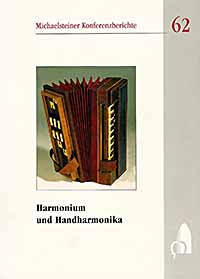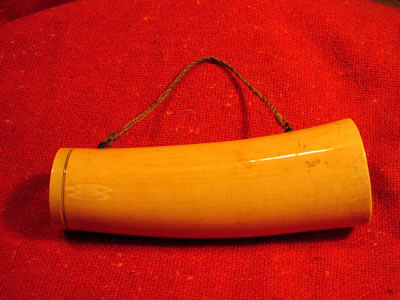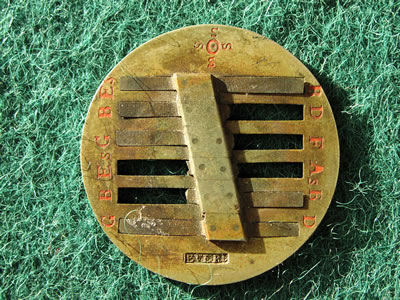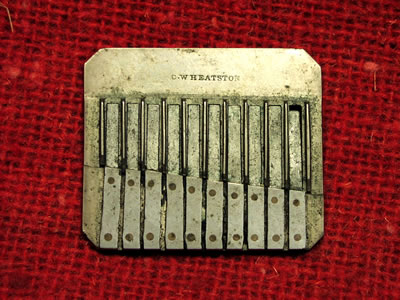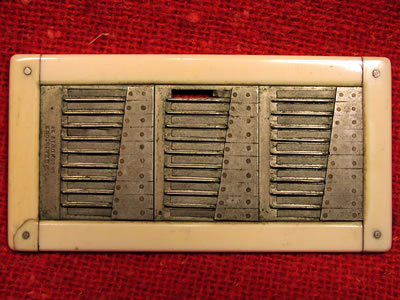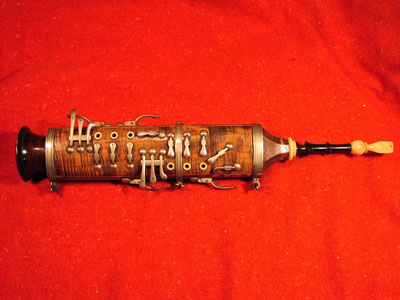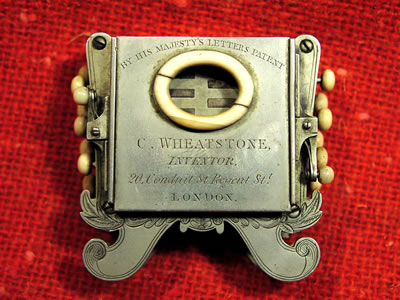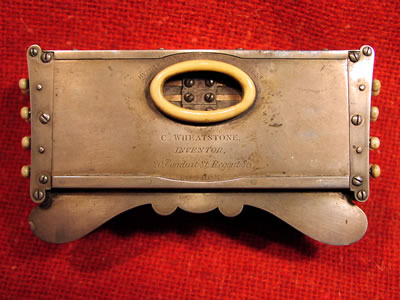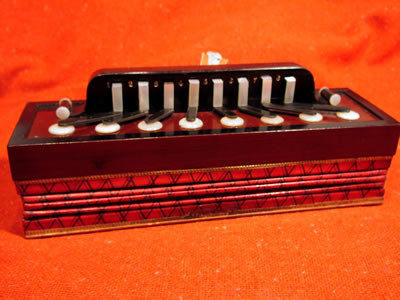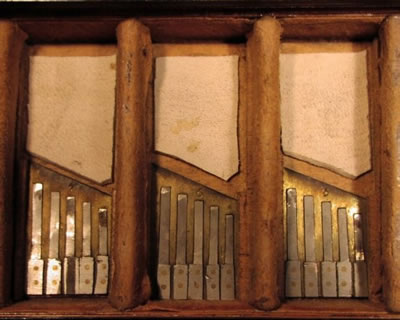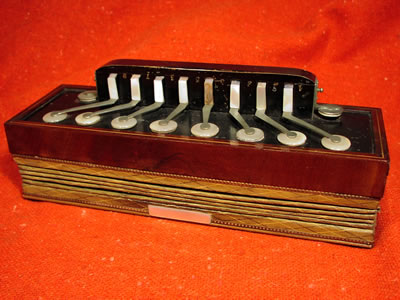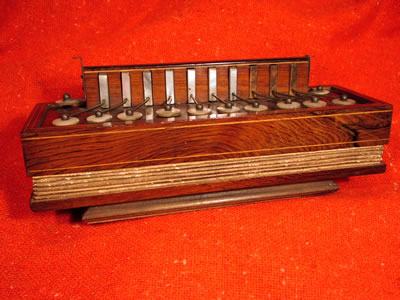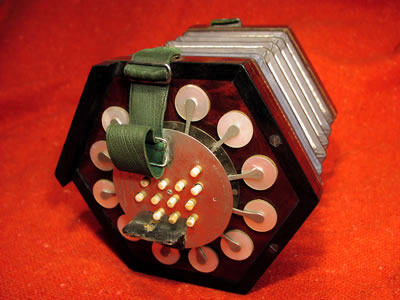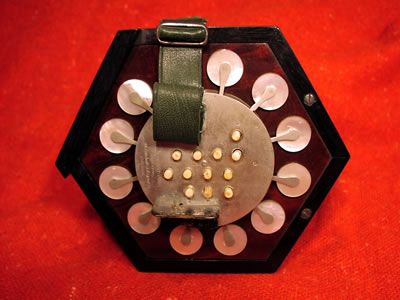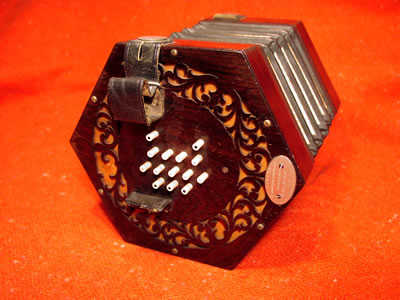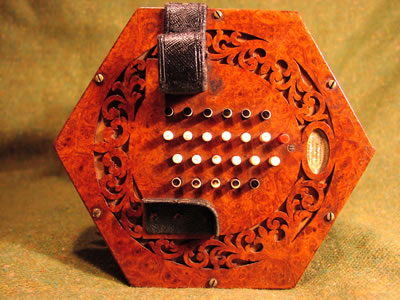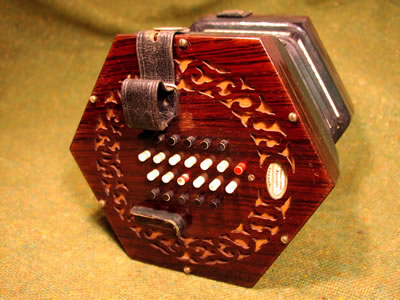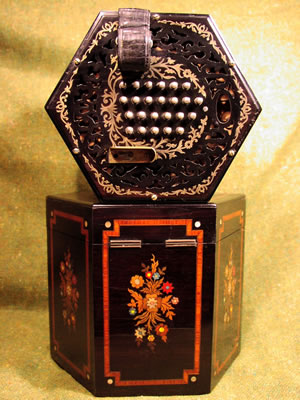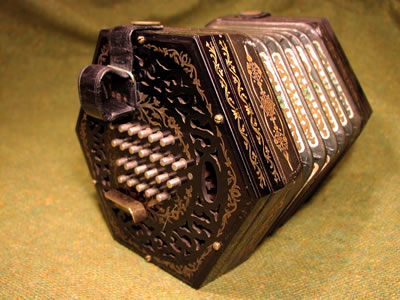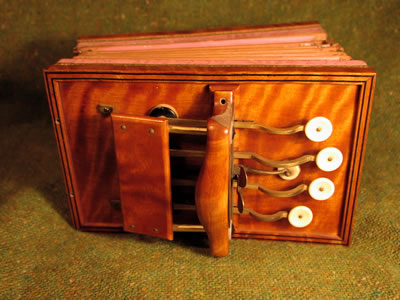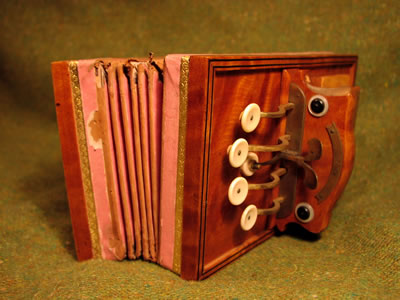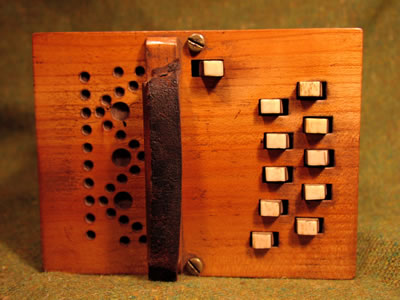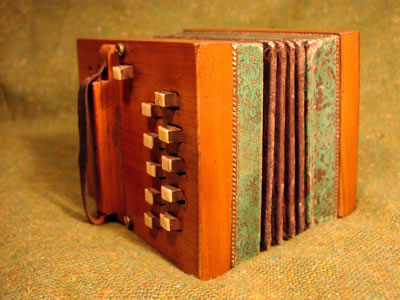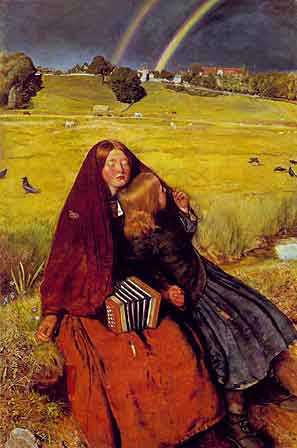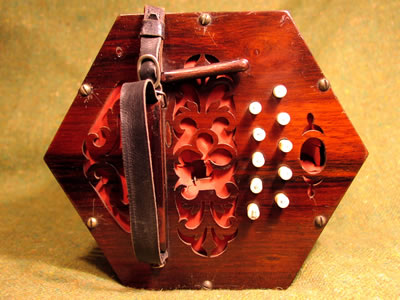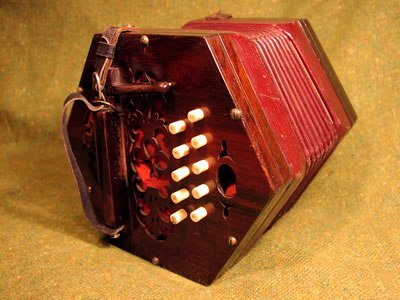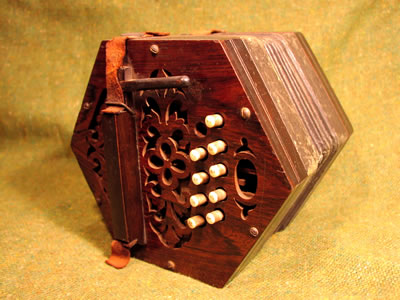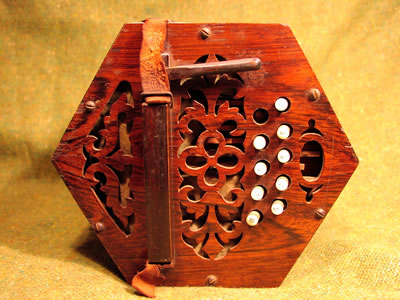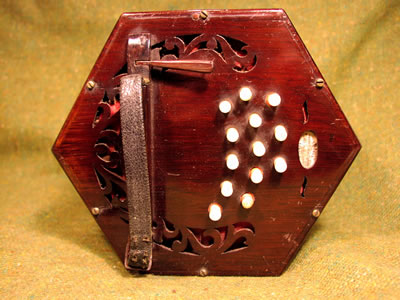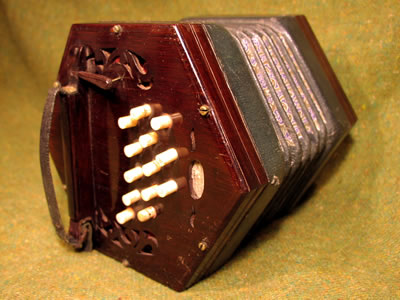1. Æolinas
It was claimed, in an anonymous 1830 instruction book,
The German Æolian Tutor,2
that "this elegant little instrument was first brought to England
from Germany, early in the year 1827, by the Right Hon. Earl
Stanhope".3
The instrument was
demonstrated at a Royal Institution lecture of Charles Wheatstone's on 9th May
18284
and an article,
featuring an engraving of a Wheatstone triple æolina, appeared in The Harmonicon
for February 1829.5
These simple mouthorgans consist of a metal plate to which are
riveted a number of free reeds, usually tuned to play a chord, though chromatic versions were also made.
They were the first commercially successful European free reed instruments and led directly to the
invention of the accordion, the English concertina (via the symphonion), the German concertina and
(of course) the modern mouthorgan/harmonica family.
[1]
German double æolina stamped "Evers" and also with a device consisting of an oval with an “S” at
each quarter (see photograph), circa 1828. Circular German
silver6
reedplate with two chords, tonic
(Eb major) and dominant (Bb7), stamped, in German notation, G B Es G B Es and B D F As B D,
mounted in an ivory horn with a circular ivory mouthpiece. Probably a “Hunting Æolian, two Chords
of six notes each, mounted in Ivory”, as described in a “List of German Æolians Manufactured and
Imported by Willis & Co.” contained in The German Æolian
Tutor.7
[2]
Single æolina stamped "C. Wheatstone", London, circa 1828. German silver reedplate and (ten)
reeds. Wheatstone' s æolinas, such as this one and Exhibit 3, have ridges between the reeds to
"answer the double purpose of protecting them from injury, and guiding the lips of the
performer"8
to facilitate the playing of single notes.
[3]
Triple æolina stamped "C. Wheatstone, 20, Conduit St.", London, c. 1829, consisting of
three single æolinas mounted in an ivory frame. The chords are "tuned so as to form the perfect
major chords on the tonic, dominant and subdominant of the key... By this arrangement a complete
diatonic scale, extending through three octaves, is obtained; any unmodulating melody may,
therefore, be performed upon it, and be accompanied by the three simple harmonies of the
key".9
2. Keyed mouth organs
An assortment of mouth organs with keys soon appeared in Germany, France and England, no doubt
in an attempt to facilitate the playing of individual notes.
[4]
Psallmelodikon, invented by J. Weinrich & H. König of Heiligenstadt in 1828, a similar example
(with a more fanciful windpipe) is shown in a portrait of Weinrich dating from
1835.10 Flamed maple
body, 6 fingerholes plus 2 thumbholes bushed with ivory, 25 German silver saltspoon keys in saddles,
German silver reeds, ivory mouthpiece. In external appearance resembling a double-flageolet with some
bassoon-like features, the body must have been built by a maker of woodwind instruments.
[5]
Symphonion with 15 keys, engraved "BY HIS MAJESTY'S LETTERS PATENT, C. WHEATSTONE, INVENTOR, 20,
Conduit St. Regent Stt. LONDON.” circa 1829, an early example numbered 18. German silver body with
decorative engraving, silver reeds, ivory buttons and embouchure. When first made this instrument had
only 13 diatonic buttons in two rows, producing the two F# semitones by means of levers shortening the
F natural reeds,11
the two external saddle-mounted keys for F# and their
respective reeds being a contemporary modification.
[6]
Symphonion with 32 keys engraved "BY HIS MAJESTY'S LETTERS PATENT, C. WHEATSTONE, INVENTOR, 20
Conduit St. Regent St., LONDON.” 1831 or 1832. The only known sterling silver symphonion, hallmarked
London 1831-2, gold reeds, ivory buttons and embouchure. A more developed model than the last, with
four chromatic rows of buttons. The very logical fingering system of the symphonion was the main subject
of Charles Wheatstone's 1829 Patent12;
it was later to be used for his English concertina, which was
therefore covered by the Patent though not a subject of it.
3. Accordions
Invented by Cyrill Demian (1772-1847) of Vienna and patented by him on 6th May
1829,13 the accordion
rapidly spread throughout Europe. lt had certainly reached London as early as 1830 because it is recorded
that a 5-key example was seen at one of Wheatstone's lectures to the Royal Institution on 5th June that
year,14
there was also a tutor published in London for it the same
year.15
These very first models of accordion were made to be played left-handed (to our way of
thinking)16
and played only chords, as contemporary tutor books explain and surviving instruments demonstrate
(hence the name, deriving from the German word for chord = "accord", plus the suffix "-ion").
This has been the cause of some considerable confusion and misinformation in books and articles on
the subject by writers who have not taken the trouble to research the source material, or had their own agenda.
In essence the first model consisted of a series of æolinas arranged inside a wooden box provided with a
bellows and keys. On pressing a key one chord would sound on compressing the bellows and another chord on
expanding them, thus allowing the playing of tunes only with the respective chordal harmony for every melody note.
Over the next few years the accordion developed and became more melodic. An early modification was to
incorporate a “mutation”, consisting of a plunger projecting from the keyboard end of the instrument,
which, when pushed against the body of the performer, caused dampers to be pressed against the
unwanted reeds of the chords, silencing them, so that only the root note sounded. Such instruments
are described and illustrated in Adolf Müller’s
Accordion Schule17
and an example from the
Germanisches Nationalmuseum, Nürnberg, was demonstrated at the Symposium by
Dieter Krickeberg18
playing a piece from its associated instruction
book.19
On other models the number of reeds sounded
by each key was reduced in number so that they played only a two-note harmony or just single notes
and a pair of sliding "mutation" keys to provide the option of a simple fixed bass or chord accompaniment,
if opened, were added one at each end of the treble keyboard. Accordions with right-handed keyboards
then started to be made and by the middle of the 1830's, instruments with "spoon-bass" keys mounted
on the opposite end-board had begun to appear.20
By 1840, Viennese accordions with an enclosed treble action and a pair of bass keys mounted
on the side of the opposite end were being produced, in essence the "Vienna accordion" as we define the term
today.21
In the early 1830's a number of Parisian makers began building copies of Demian's single note
accordions, but with the press/draw system of notes reversed, similar to the earliest models, and a right-handed keyboard.
[7]
Unlabelled accordion with 8 keys in the manner of Cyrill Demian, Vienna, first model c. 1829.
Mahogany veneered body, ebonised edging, keyboard and levers, mother of pearl pallets and keys, 3-fold pink
leather bellows, German silver reeds arranged in 5-note chords per brass plate, those on the press numbered
I to VIII and on the draw 1 to 8, keys numbered (left to right) 1 to 8 for left-handed playing. The scale
of this instrument differs from later models, starting on key 2 and playing DRAW/PRESS, 3-DRAW/PRESS,
4-DRAW/PRESS, 5-DRAW/PRESS. Mother of pearl fingerplate engraved with the name "Emily"
(presumably the original owner?). The wind key on these early Viennese instruments consists of a
simple sprung “trapdoor” arrangement, mounted internally and hinged at one end, it is operated by
inserting a finger of the hand moving the bellows through one of the mother of pearl bushings in
the end board (the air also passing through these bushings).
The accordion shown in the Patent has only 5 keys but Demian was making models with 5, 6, 7, 8, 9
or 10 keys as early as July 1829.22
[8]
Viennese accordion, circa 1835, with 8 keys numbered (right to left) 1 to 8 for
right-handed playing, plus two "mutation" keys at ends of fingerboard. Mahogany veneered body,
4-fold pale green leather bellows, German silver levers, mother of pearl pallets and keys,
single German silver reeds. Internally numbered (Model?) "N* 1.0." The scale of this instrument
starts on key 1 and plays PRESS/DRAW; 2-PRESS/DRAW, 3-PRESS/DRAW, 4-DRAW/PRESS in what has become
the usual manner (blow/suck, blow/suck, blow/suck, suck/blow, just like a harmonica). The
wind key of the same style as Exhibit 7.
[9]
French accordion, Paris, circa 1835, with 10 keys plus two brass "mutation" keys at ends
of fingerboard. Rosewood veneered body, 4-fold leather bellows, brass wire levers, mother of pearl
pallets and keys, single brass reeds. Internally numbered "41a". The scale of this instrument starts
on key 2 and plays DRAW/PRESS, 3-DRAW/PRESS, 4-DRAW/PRESS, 5-PRESS/DRAW. Brass spoon shaped wind key
enclosed within a protective moulding.
4. English concertina
Charles Wheatstone's Patent of 182923
shows a version of his symphonion with a bellows, but
it is still far removed from an English concertina. He would seem to have combined elements of
Demian's accordion with elements of his own symphonion (including the fingering) to produce his
prototype concertina (see Exhibit 10 below). The instrument was first known simply as “the concertina”
until German concertinas started to appear in Britain in the late 1840’s and the qualification “English”
became necessary.
[10]
Open pallet model, prototype English concertina, engraved, on the circular German silver
keyboard plate, "BY HIS MAJESTY'S LETTERS PATENT, C. WHEATSTONE, INVENTOR, 20, Conduit St.
Regent St., LONDON.” circa 1833. 24 ivory buttons, hexagonal mahogany veneered ends with
ebony trim, 4-fold leather bellows (with "bookbinder
corners"),24 buckled leather thumbstraps,
exposed action, saddle mounted German silver levers, individual blued steel reeds on rectangular
brass plates, mother of pearl pallets.
This venerable instrument was preserved by the firm of Wheatstone & Co. in their own Collection.
It is illustrated (dated by them to 1829) in the various editions of their "blue book" catalogues
from the 1950's. The same photograph is also used as an illustration in Pierre Monichon's
Petite Histoire de
L'Accordéon25
and his L'Accordéon.26
I have dated it to 1833 on the evidence of an anonymous early concertina tutor book which gives
an otherwise accurate account of Wheatstone's early work with free reeds and states
that "it was not till the end of the year 1833 that the instrument named the Concertina was
invented".27
There is no contemporary evidence to suggest it existed before that time.
[11]
32-key English concertina, engraved oval German silver label "BY HIS MAJESTY'S LETTERS PATENT,
112, C. WHEATSTONE, INVENTOR, 20,Conduit St. Regent St., LONDON." Concertina no. 112, sold to Mr Woolwright
on 5th November 1836. An early example of a concertina with fretwork to protect its intricate, handmade,
brass mechanism. Ivory buttons, the naturals stamped with the note names, the accidentals with black inserts,
rosewood fretcut ends, 4-fold green leather ("bookbinder") bellows, German silver reeds, original green leather
(chamois lined) thumbstraps with German silver topscrews.
[12]
48-key English concertina by C. Wheatstone, London, no. 649, sold to Giulio Regondi on
18th April 1843. Coloured ivory buttons, the naturals stamped with the note names, the C's stained red,
the accidentals black, amboynawood (a deluxe finish) veneered fretcut ends, 4-fold green leather bellows
with rounded corners, German silver reeds, oval paper label (“BY HIS MAJESTY' S LETTERS PATENT...").
This instrument contains a much simpler (to manufacture) action than the last example, but it is
still largely hand made. Its 48-button range was becoming more or less standard from this time onwards
(it still is) giving the English concertina the same range as a violin.
Giulio Regondi (1822–1872) was a Swiss-born child prodigy on the guitar, before taking up the newly
invented concertina (by 1834) and becoming its first and greatest virtuoso. He did much to popularise the instrument.
[13]
48-key English concertina by C. Wheatstone, no. 1563, circa 1848. Coloured ivory buttons
(as Exhibit 12), rosewood veneered ends with spindlecut "frets", green leather bellows, brass reeds,
oval paper label: "BY HER MAJESTY'S LETTERS PATENT..." refers to Wheatstone's later Patent of
1844.28
The earliest known example of a "mass produced" Wheatstone, following the mechanisation and production
techniques developed for Wheatstone's by the (also Swiss-born) engineer Louis Lachenal
(1821-1861).29
[14]
An extremely fine 48-key English concertina by Louis Lachenal, London, no. 15347, circa 1870.
Silver capped German silver buttons, ebony veneered ends with spindle-cut "frets" inlaid with intricate
engraved German silver floral swags, the end bolts, engraved finger plates and engine-turned top screws
all gold plated, steel reeds, 5-fold green leather bellows with gold tooling and fancy printed decorative
papers. The ebony veneered case with floral marquetry, mother of pearl and composition inlay, bordered in kingwood.
Both the instrument and its case are most opulently decorated and it is very tempting to speculate
that they may have been made for exhibition purposes. Louis Lachenal set up his own business in 1858,
following the expiration of Wheatstone's 1844 Patent, having produced nearly all of that firm's concertinas
in the preceding ten years.
5. German system concertinas
The invention of the German concertina is attributed to Carl Friedrich Uhlig (1789-1874) of Chemnitz,
who first advertised a “new kind of Accordion” in the Chemnitzer Anzeiger of 19th July
1834.30
“Each side had 5 buttons, each button two tones”.31
(Hence it was called a “20 töniges Accordion”.)
However, I am not aware of any more detailed record of its earliest form and it is intriguing to
speculate that the astonishing instrument by the German-born Jew’s harp virtuoso Charles Eulenstein
(see Exhibit 15 below) may represent a contemporary English-made imitation of it. There had
certainly been documented links between Wheatstone and Eulenstein since
182832
and it seems
reasonable to suppose that this instrument was probably built for him by some of Wheatstone's
craftsmen after his trip home (to Heilbronn and Lüneburg in order to marry) in July/August 1834
and based on a German original. However, the possibilities are intriguing: Was it instead made by
Uhlig? Or even, could Eulenstein have been the true inventor? Certainly he seems to have been in
Germany at an opportune time.
[15]
A unique 10-key Anglo-German concertina by Charles Eulenstein, Bath, 1835. Engraved "C. Eulenstein,
INVENTOR, No.4", rectangular flamed maple body with open pallet action, brass levers, 4 ivory buttons plus
one brass "butterfly" key on each end, (later?) bass soundbox, (moth-eaten) 5-fold leather bellows,
individual steel reeds. The escutcheon on the case is engraved with the owner's initials and the year "1835",
making it the earliest dateable German model concertina.
Curiously Eulenstein made no mention of any concertina invention in his
autobiography,33 though he
did refer to an (unsuccessful) eight-string guitar called an "octina" which he invented (only selling
six of them) and a very successful German grammar which he wrote, both around this time. Perhaps
he sold even less concertinas than guitars?
[16]
German 20-key concertina, circa 1855, the maker's name, "Pirner", is pencilled inside
the right-hand end, numbered 240. Rectangular fruitwood body pierced with a drilled design,
rectangular bone capped wooden keys, 4-fold leather bellows, 10 German silver reeds mounted on
each of four reedplates. "Carl Friedrich Pirner, Harmonicafabrik, Mühlenstrasse 33" appears in
the Chemnitz Adressbuch for 1855, 1857 and
1858.34
An almost identical concertina is depicted in Sir John Everett Millais’ painting The Blind Girl (painted 1854–1856,
now item No. 1892P3 in the collection of the Birmingham Museums and Art Gallery).
It is known to have been borrowed for the picture in 1855, at which time it was not new.
[17]
Anglo-German 20-key concertina by the Nickolds family, London, early 1850's. Bone buttons
numbered 1–10 each side, "Artistic fingering", hinged wooden wind-key, hexagonal rosewood ends with
simple fretwork (left hand end replaced in stained mahogany), individual brass reeds, 8-fold maroon leather bellows.
The Nickolds family claimed to be "inventors of the Anglo-German" concertina on their business
card35
and they probably were the first to manufacture the basic 20 key model, combining English construction
and hexagonal shape with German fingering. They established their own business in 1848 (having previously
worked for Wheatstone’s) and probably developed the Anglo-German concertina around the time of the
Great Exhibition of 1851 (which seems to have helped to popularise the German concertina in Britain).
[18]
German made concertina, 1850’s. Externally an imitation of the above instrument, with hexagonal
rosewood veneered ends of the same fret pattern, bone capped wooden buttons numbered 1–10 each side,
hinged wooden wind-key, 5-fold green leather bellows. The internal construction is German in style,
with buttons glued to wooden levers and 10 brass reeds per reedplate. Such instruments would have
been built for export, but probably the hexagonal shape became adopted for German-model concertinas
as a result of this. (The hexagonal shape is necessary for the radial construction of an English
concertina, but not for German construction)
[19]
26-key Anglo-chromatic concertina by George Jones, London, no. 246, circa 1858. Bone buttons
numbered 1–10 for naturals, semitones indicated with note names on buttons, hinged wooden wind-key,
hexagonal rosewood ends with simple fretwork, individual brass reeds, 5-fold green leather bellows.
Oval paper label "G. JONES, PATENT CONCERTINA Manufacturer, LONDON."
George Jones claimed to have added the first semitones to the German system, making a
22-key instrument, for his own use in 1851 and his "chromatic Anglo-German" with 26 keys three
years later.36
However, it was not until after the death of his employer Jabez Austin, in July 1857,
that he started to manufacture concertinas bearing his own name. The date 30/12/61 is written inside
this Instrument but it most probably relates to an early repair.
Acknowledgements
My thanks to Maria Dunkel and Dieter Krickeberg, both of whom I first met at the Symposium,
for their interest and kind help.
Especial thanks to Peer Ehmke at the Schloßbergmuseum Chemnitz, with whom I have exchanged a lot of ideas,
information and photocopies as a result of our mutual involvement in the Exhibition
“Sehnsucht aus dem Blasebalg,”
(and see particularly its "Galerie"
with photographs of instruments)
held at the Museum, 1st July—28th October 2001.
My knowledge has been greatly enriched by my contact with them and I could not
otherwise have rewritten my catalogue with so much additional information.
Also thanks to Stuart Eydmann, who inspired me to spend years looking for elusive source material
when he gave me a photocopy of the article about The Æolina from The Harmonicon
(when I already owned the triple æolina but didn’t know what it was).
Author
Stephen Chambers
(
)
is a leading authority on the history of the concertina and a collector of early free reed
instruments; he has worked as a music librarian in London and was for many years proprietor
of the venerable John McNeill music store (est. 1834) in Dublin. He has recently moved to Kilrush,
Co. Clare, where he intends to set up a concertina and squeezebox museum with his collection,
and to start manufacturing concertinas.
